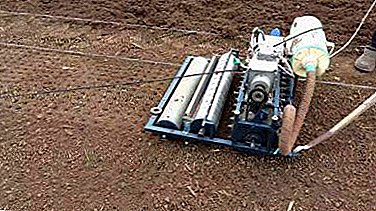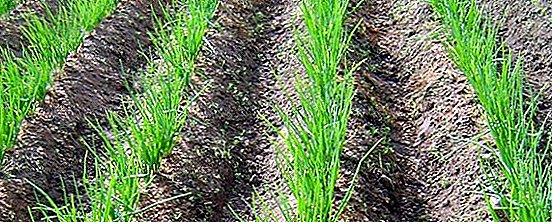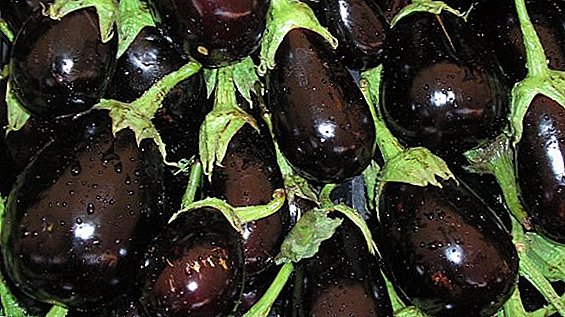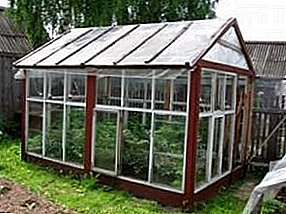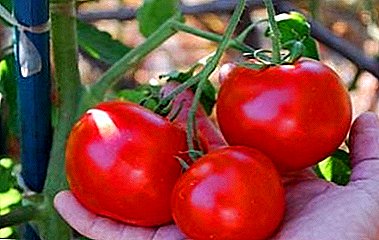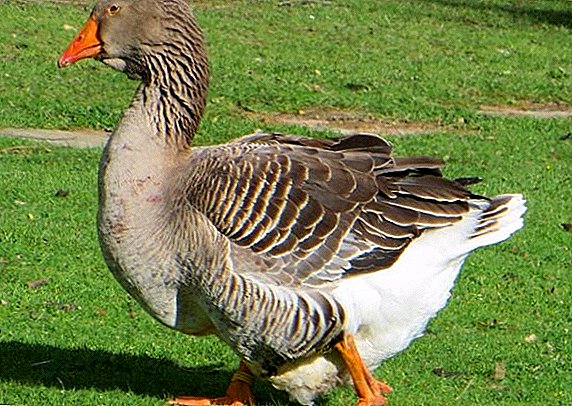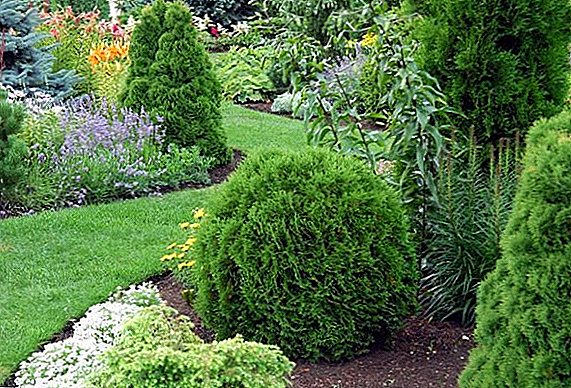 Slender cypress look harmoniously in any landscape landscape. In the summer, they create a contrast in the flowering compositions, and in the winter they rid the garden of dull grayness. The ornamental variety of bushes of these evergreens will satisfy any gardener. The one who is looking for a tree in the form of a candle, and one who wants to see a neat elfin tree or a short branched shrub in his compound will find a coniferous plant for himself. What types of this culture better take root in our latitudes, and with which varieties it is easier to find a common language in nursing, we learned from experts.
Slender cypress look harmoniously in any landscape landscape. In the summer, they create a contrast in the flowering compositions, and in the winter they rid the garden of dull grayness. The ornamental variety of bushes of these evergreens will satisfy any gardener. The one who is looking for a tree in the form of a candle, and one who wants to see a neat elfin tree or a short branched shrub in his compound will find a coniferous plant for himself. What types of this culture better take root in our latitudes, and with which varieties it is easier to find a common language in nursing, we learned from experts.
Important! Cypress trees are valued for their healing properties and wood quality. They grow very long and cost a lot. Therefore, to make the purchase of such plants should be exclusively in garden centers or nurseries. Feel free to ask questions to specialists and carefully check the instances you like.
Cypress: General Description
Cypress conifers (Chamaecyparis), which belong to the genus Cypress, came to us from North America and East Asia. In the range they reach a height of 60 - 70 meters and resemble a cypress. Sometimes even experienced gardeners make mistakes in distinguishing these similar crops. Both plants have a scaly bark of a rich brown color with deep sections, a cone-shaped crown with wilted or open branches, thick needles, which happens with blue, yellow and gray shades.
But still, cypress and cypress are not the same thing, their main differences are in frost resistance, features of branches and cones. Cypress, despite the genetic adaptability to mild climatic conditions, tolerates harsh winters. Its shoots are flatter, and the fruits ripen during the year, their scales contain only two grains.
 Cypress trees began to appear in the gardens from the end of the 18th century. Today, more than 200 decorative names of this culture are known worldwide, but not all of them are adapted to moderate climatic conditions. Four types of cypress trees are cultivated in Ukraine: nutkansky, pea-fruit, stupid and Lawson.
Cypress trees began to appear in the gardens from the end of the 18th century. Today, more than 200 decorative names of this culture are known worldwide, but not all of them are adapted to moderate climatic conditions. Four types of cypress trees are cultivated in Ukraine: nutkansky, pea-fruit, stupid and Lawson.
Although most experts tend to think that the main difference between these plants lies in their decorativeness and pace of development. Breeders annually replenish varietal collections. Recently, Japanese works have occupied an impressive niche in the market, which stands out among the other weeping, pyramidal and spherical crowns.
In the care, all cypress trees easily adapt to the soils, prefer loose and drained substrates. Plants love penumbra. The conifers turn yellow in the sun and liveliness is lost, so there is a need for regular moistening of the soil and air. When choosing a site for landing, it is important to avoid lowlands where cold air accumulates. In the spring, conifer needles cover up, hiding from sunburn, and in winter, young saplings of some varieties shelter from frost. Culture lends itself well to formative pruning.
Did you know? The oldest kriparisovik grows in Taiwan. The tree is over two thousand years old.
The best varieties of cypress Lawson
Representatives of this species are considered the highest cypress trees. In their natural environment, their trunks reach a height of 70 meters, and in culture - about 50-60 meters. Lawson's cypress trees seduce with a cone-shaped crown with colorful needles, which, depending on the variety, can be smoky blue, bright green with a brown tint, golden, rich yellow, silver, light green.
These plants are scaly needles and bark resemble thuja and are among the most sold. They have many forms, including weeping and dwarf. Gardeners in the reviews describe the culture as fast-growing, shade-tolerant, moisture-loving and unpretentious in the care. The only drawback of Lawson's cypress is called weak frost resistance. That is why the branches of elfin trees recommend pinning to the ground in order to safely winter. But even in such conditions, a dense layer of snow is dangerous, since under it the shrub can melt.
Non-growing varieties of over 80 cm are popular: "Gnom", "Minima", "Minima glauca", "Minima aurea". And:
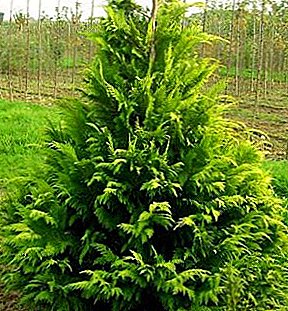 Lawson's cypress "Golden wonder" is a tree with a slender trunk up to seven meters high and a conical crown with a diameter of 2.5 - 3 meters. Poorly developing. The branches are powerful and thick. The annual growth of sprouts is about 15 cm, and the crowns in the volume are no more than 10 cm. On young shoots, conifer needles are tightly pressed, golden-yellow in color, with time they are filled with sunny tones. It is characteristic that the coloring of Lawson's cypress "Golden Wonder" does not fade in winter and looks very impressive against a snowy or snowless background. The tree has a superficial, highly branched root system. Consequently, it painfully reacts to poor compacted soils and drafts, does not like the wind. In landscape design, this breed is recommended for single landings.
Lawson's cypress "Golden wonder" is a tree with a slender trunk up to seven meters high and a conical crown with a diameter of 2.5 - 3 meters. Poorly developing. The branches are powerful and thick. The annual growth of sprouts is about 15 cm, and the crowns in the volume are no more than 10 cm. On young shoots, conifer needles are tightly pressed, golden-yellow in color, with time they are filled with sunny tones. It is characteristic that the coloring of Lawson's cypress "Golden Wonder" does not fade in winter and looks very impressive against a snowy or snowless background. The tree has a superficial, highly branched root system. Consequently, it painfully reacts to poor compacted soils and drafts, does not like the wind. In landscape design, this breed is recommended for single landings.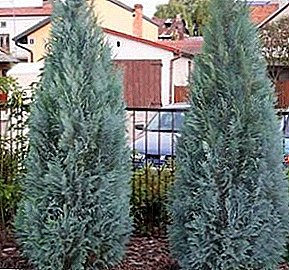 Loveson's cypress "Kolumnaris Glauka" was bred at the beginning of the 20th century in a Dutch nursery. It is a tree with a straight trunk up to 10 meters high and a crown in the shape of a narrow pyramid with a diameter of up to two meters. The branches are directed upwards. The shoots are thin and short, developing rapidly. Their annual growth is about 20 cm, and in the amount of about 5 cm. Needles with a bluish or metallic tinge for the winter are gray. The roots are powerful, branching out in the upper balls of the earth. The plant prefers sunny areas. In landscape design is used for compositions and single landings, as well as for hedges.
Loveson's cypress "Kolumnaris Glauka" was bred at the beginning of the 20th century in a Dutch nursery. It is a tree with a straight trunk up to 10 meters high and a crown in the shape of a narrow pyramid with a diameter of up to two meters. The branches are directed upwards. The shoots are thin and short, developing rapidly. Their annual growth is about 20 cm, and in the amount of about 5 cm. Needles with a bluish or metallic tinge for the winter are gray. The roots are powerful, branching out in the upper balls of the earth. The plant prefers sunny areas. In landscape design is used for compositions and single landings, as well as for hedges.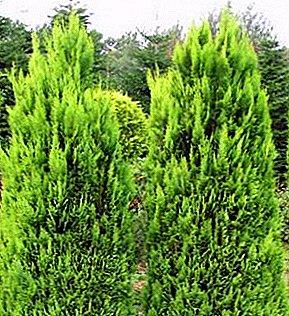 Cypress "Alyumigold" - a tree with a narrow pyramidal shape and yellowish needles. The crown core is brighter and lighter. The variety was the result of the mutation "Alumi", which is notable for its trunk height. Mature specimens reach eight meters in height. Branches directed upwards, razlohe. The species adapts well at low temperatures, is drought tolerant, needs acidic soils.
Cypress "Alyumigold" - a tree with a narrow pyramidal shape and yellowish needles. The crown core is brighter and lighter. The variety was the result of the mutation "Alumi", which is notable for its trunk height. Mature specimens reach eight meters in height. Branches directed upwards, razlohe. The species adapts well at low temperatures, is drought tolerant, needs acidic soils.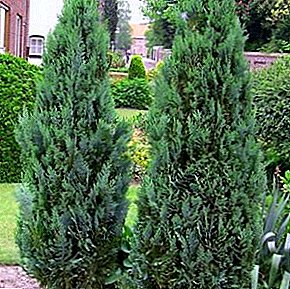 Loveson's cypress "Columnaris" has a slender trunk up to 10 meters high and a narrow crown of a columnar shape with a diameter of up to two meters. The branches grow upwards, powerful and flexible. Shoots are short and thick, added annually to 20 cm. Needles of green-brown tones. The rhizome is located superficially. The tree adapts to any soil, endures drought, loves sunny places. Cultivated as a hedge.
Loveson's cypress "Columnaris" has a slender trunk up to 10 meters high and a narrow crown of a columnar shape with a diameter of up to two meters. The branches grow upwards, powerful and flexible. Shoots are short and thick, added annually to 20 cm. Needles of green-brown tones. The rhizome is located superficially. The tree adapts to any soil, endures drought, loves sunny places. Cultivated as a hedge.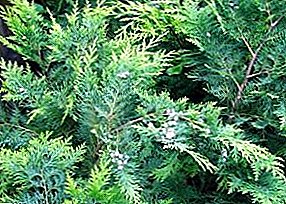 Lawson's Cypress Stardust is highly resistant to frost. It is a straight tree up to 10 meters high and up to 4 meters wide. The branches form a slightly open pyramidal or conical shape. From the trunk are scattered asymmetrically, hang down at the ends. Sulfur needles with a yellow tinge, fan-shaped. For the year, sprouts add 20 cm in height and 8 cm wide. Variety cypress "Stardust" recommended for unique plantings.
Lawson's Cypress Stardust is highly resistant to frost. It is a straight tree up to 10 meters high and up to 4 meters wide. The branches form a slightly open pyramidal or conical shape. From the trunk are scattered asymmetrically, hang down at the ends. Sulfur needles with a yellow tinge, fan-shaped. For the year, sprouts add 20 cm in height and 8 cm wide. Variety cypress "Stardust" recommended for unique plantings.
Important! Forming haircut should be carried out in strict compliance with sanitary standards. Otherwise, the risk of fungal infections of the culture increases, which is reflected in its decorative effect.
Description and photo of pea-cypress cypress
This species deserves attention not only for its decorative effect, but also for the highest degree of cold resistance compared to its counterparts. Cypress-pea can easily survive 30-degree frosts and does not burn at all during the first spring rays. It is characterized by smoky blue short needles, smooth red bark, brown fruits with yellowness. Shoots grow slowly, fanlike. Until the age of 10, the tree reaches 1.5 meters in height. In favorable conditions, the trunk develops up to 10 meters.
Plants of this species require regular sprinkling, they take root well in sunny areas with rich chernozem soil, they do not tolerate limestone and stagnant water. In the culture, there are more than a hundred names of varieties of pea-bearing fruit. Recognized as the best:
 The cypress "Bolivar" is a mutation of the "Sguarrosa" variety. Differs lower trunk and compact crown in the form of a pin and the color of the needles, which varies depending on the season. In the summer, the needles are greyish-blue, and in the spring they become silver or bronze. Young trees develop slowly, prefer well-lit areas, moisture and fertile substrate. The height of a mature tree is about 2 meters, the diameter of the crown is 1 meter. For its formation, the upper shoots pinch. The variety has a dwarf clone "Baby Blue" (New Boulevard).
The cypress "Bolivar" is a mutation of the "Sguarrosa" variety. Differs lower trunk and compact crown in the form of a pin and the color of the needles, which varies depending on the season. In the summer, the needles are greyish-blue, and in the spring they become silver or bronze. Young trees develop slowly, prefer well-lit areas, moisture and fertile substrate. The height of a mature tree is about 2 meters, the diameter of the crown is 1 meter. For its formation, the upper shoots pinch. The variety has a dwarf clone "Baby Blue" (New Boulevard). "Filifera" is a tree up to 5 meters tall with drooping small-leafed branches. He is the founder of many other forms that are highlighted in color needles. For example, "Filifera Aurea" (yellow-gold), "Filifera Gracilis nana" (yellow-green, dwarf), "Filifera Sungold" (silver, dwarf). Breed adapts on solar and in priteny places, it is well combined with other plants in rock gardens and mixborders.
"Filifera" is a tree up to 5 meters tall with drooping small-leafed branches. He is the founder of many other forms that are highlighted in color needles. For example, "Filifera Aurea" (yellow-gold), "Filifera Gracilis nana" (yellow-green, dwarf), "Filifera Sungold" (silver, dwarf). Breed adapts on solar and in priteny places, it is well combined with other plants in rock gardens and mixborders.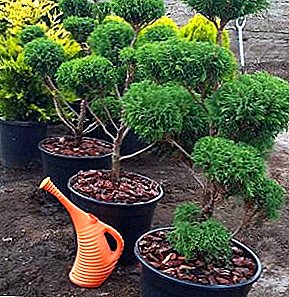 "Plumosa" - slow-growing cypress, in adulthood reaches a height of 10 meters. At the age of 10, the tree develops up to 1.3 meters, breadth up to 0.6 meters. Needles are styloid, short, always saturated green. The culture is sun-loving, does not tolerate drafts. It has related forms: “Plumosa aurea” (with golden needles), “Plumosa Compressa aurea” and “Plumosa Nana aurea” (dwarfs).
"Plumosa" - slow-growing cypress, in adulthood reaches a height of 10 meters. At the age of 10, the tree develops up to 1.3 meters, breadth up to 0.6 meters. Needles are styloid, short, always saturated green. The culture is sun-loving, does not tolerate drafts. It has related forms: “Plumosa aurea” (with golden needles), “Plumosa Compressa aurea” and “Plumosa Nana aurea” (dwarfs).- "Aurea" develops up to 3 meters in height, the diameter of the crown is about 1.5 meters. Needles bright yellow.
Important! In the central regions of Ukraine, cypress trees are advised to be planted on fertile loams, and in the northern zone of the country the ground must be sour and loose, preferably supes.
Nutcar cypress
This species differs from other cypress trees in late terms of seed ripening, which confuses novice gardeners, and they often confuse a tree with cypresses. The Nuthkan breed is famous for its North American origin and the slow development of sprouts. Scientists consider dark green short needles, gray-brown bark and spherical fruits to ripen in the second year as typical signs of the species. Given these features, some botanists include the Nutkan cypresses, or, as they are also called, yellow xantocyparis to the genus.  In the area, the tree reaches 40 meters in height, the cultivated forms are much lower, which allows them to blend in with the neighboring plants in the garden. Gardeners note the winter hardiness of culture and endurance to droughts, but warn of vagaries - cypress loves sunny areas and moisture, it can freeze in severe frosts.
In the area, the tree reaches 40 meters in height, the cultivated forms are much lower, which allows them to blend in with the neighboring plants in the garden. Gardeners note the winter hardiness of culture and endurance to droughts, but warn of vagaries - cypress loves sunny areas and moisture, it can freeze in severe frosts.
Nutkansky view is represented by only 20 decorative forms. The following varieties are in demand:
- Cypress "Pendula" - a weeping conifer. By the way, the most beautiful of all these. In adulthood, reaches 15 meters in height. It has dark green needles.
- "Glauca" attracts with emerald shades of needles and a crown in the form of a narrow cone. It develops up to 6 meters, breadth up to 1.2 meters. The branches are short, flexible. To preserve the blue needles, it is recommended to plant in a sunny place.
- "Jubilee" stands out for its narrow columnar shape with bright green needles. Branches wilted.
- "Lutea" is a tall weeping tree with bright needles of greenish hues.
- "Viridis" has a brighter foliage.
Did you know? Conifers with golden leaves should be planted in open sunny areas.
Popular cultivars of cypress
The cypress tree is commonly called white cedar, in Ukraine it is found on the Black Sea coast. Bad winters, can not tolerate dry air and soil. The advantage of the species is resistance to diseases and pests, and unpretentiousness in care. The tree prefers eastern and western areas, moderate humidity. In the natural environment it develops up to a 20-meter height, in culture much lower. It has a thick brown bark, pointed needles bluish and green.  Of the registered 40 varieties in the private collections fall:
Of the registered 40 varieties in the private collections fall:
- "Andalyensis" - a compact bush in the form of a wide pyramid. Needles subulate bright blue-green color. In winter, acquire purple hues.
- "Variegate" deserves the attention of variegated needles. Some needles are cream colored.
- "Ericoides" - cypress with a kolonovidnoy openwork crown. Feature varieties - gray-green shades on old needles and blue on the young. In the winter, purple and bronze ebb appear on the needles.
Varieties of cypress stupid description
Tupol (or dull) cypress is a slim tall tree with a cone-shaped dense crown, light brown bark, branchy flat shoots and pressed blunt needles. A characteristic feature of the species is the dark green color of the leaves on the back side and whitish stripes on the inside. Fruits are small, in diameter up to 1 cm, orange shades.  In the area it is not adapted for cold winters, it prefers a mild, humid climate, and when cultivated in home gardens it requires additional conditions for wintering. Of the more than 130 ornamental varieties most adapted to temperate latitudes are:
In the area it is not adapted for cold winters, it prefers a mild, humid climate, and when cultivated in home gardens it requires additional conditions for wintering. Of the more than 130 ornamental varieties most adapted to temperate latitudes are:
- Blunt cypress "Dracht" - a tree with a narrow pyramidal crown and a straight trunk, which up to 10 years of age reaches 2 meters in height. The shoots are thick and thick, develop upwards. The needles are green with a gray bloom.
- "Erika" - slow-growing broad-pyramidal form. A ten-year-old tree is pulled up to 1.2 meters. The branches are magnificent, directed upwards. Needles are smoky blue. Frosts withstand badly.
- "Nana Gracilis" - dwarf variety, poorly developed. The branches form the shape of a wide oval, lean on each other. After 10 years, the tree reaches 0.5 meters, the maximum height of about 3 meters.
- "Pygmaea" is a short, cushion-shaped shrub with sprawling sprouts, flat branches. The needles are green.
- "Snowflake" - a dwarf tree with an oval crown. Crohn asymmetric, openwork, green needles, cream on the ends.


 Lawson's cypress "Golden wonder" is a tree with a slender trunk up to seven meters high and a conical crown with a diameter of 2.5 - 3 meters. Poorly developing. The branches are powerful and thick. The annual growth of sprouts is about 15 cm, and the crowns in the volume are no more than 10 cm. On young shoots, conifer needles are tightly pressed, golden-yellow in color, with time they are filled with sunny tones. It is characteristic that the coloring of Lawson's cypress "Golden Wonder" does not fade in winter and looks very impressive against a snowy or snowless background. The tree has a superficial, highly branched root system. Consequently, it painfully reacts to poor compacted soils and drafts, does not like the wind. In landscape design, this breed is recommended for single landings.
Lawson's cypress "Golden wonder" is a tree with a slender trunk up to seven meters high and a conical crown with a diameter of 2.5 - 3 meters. Poorly developing. The branches are powerful and thick. The annual growth of sprouts is about 15 cm, and the crowns in the volume are no more than 10 cm. On young shoots, conifer needles are tightly pressed, golden-yellow in color, with time they are filled with sunny tones. It is characteristic that the coloring of Lawson's cypress "Golden Wonder" does not fade in winter and looks very impressive against a snowy or snowless background. The tree has a superficial, highly branched root system. Consequently, it painfully reacts to poor compacted soils and drafts, does not like the wind. In landscape design, this breed is recommended for single landings. Loveson's cypress "Kolumnaris Glauka" was bred at the beginning of the 20th century in a Dutch nursery. It is a tree with a straight trunk up to 10 meters high and a crown in the shape of a narrow pyramid with a diameter of up to two meters. The branches are directed upwards. The shoots are thin and short, developing rapidly. Their annual growth is about 20 cm, and in the amount of about 5 cm. Needles with a bluish or metallic tinge for the winter are gray. The roots are powerful, branching out in the upper balls of the earth. The plant prefers sunny areas. In landscape design is used for compositions and single landings, as well as for hedges.
Loveson's cypress "Kolumnaris Glauka" was bred at the beginning of the 20th century in a Dutch nursery. It is a tree with a straight trunk up to 10 meters high and a crown in the shape of a narrow pyramid with a diameter of up to two meters. The branches are directed upwards. The shoots are thin and short, developing rapidly. Their annual growth is about 20 cm, and in the amount of about 5 cm. Needles with a bluish or metallic tinge for the winter are gray. The roots are powerful, branching out in the upper balls of the earth. The plant prefers sunny areas. In landscape design is used for compositions and single landings, as well as for hedges. Cypress "Alyumigold" - a tree with a narrow pyramidal shape and yellowish needles. The crown core is brighter and lighter. The variety was the result of the mutation "Alumi", which is notable for its trunk height. Mature specimens reach eight meters in height. Branches directed upwards, razlohe. The species adapts well at low temperatures, is drought tolerant, needs acidic soils.
Cypress "Alyumigold" - a tree with a narrow pyramidal shape and yellowish needles. The crown core is brighter and lighter. The variety was the result of the mutation "Alumi", which is notable for its trunk height. Mature specimens reach eight meters in height. Branches directed upwards, razlohe. The species adapts well at low temperatures, is drought tolerant, needs acidic soils. Loveson's cypress "Columnaris" has a slender trunk up to 10 meters high and a narrow crown of a columnar shape with a diameter of up to two meters. The branches grow upwards, powerful and flexible. Shoots are short and thick, added annually to 20 cm. Needles of green-brown tones. The rhizome is located superficially. The tree adapts to any soil, endures drought, loves sunny places. Cultivated as a hedge.
Loveson's cypress "Columnaris" has a slender trunk up to 10 meters high and a narrow crown of a columnar shape with a diameter of up to two meters. The branches grow upwards, powerful and flexible. Shoots are short and thick, added annually to 20 cm. Needles of green-brown tones. The rhizome is located superficially. The tree adapts to any soil, endures drought, loves sunny places. Cultivated as a hedge. Lawson's Cypress Stardust is highly resistant to frost. It is a straight tree up to 10 meters high and up to 4 meters wide. The branches form a slightly open pyramidal or conical shape. From the trunk are scattered asymmetrically, hang down at the ends. Sulfur needles with a yellow tinge, fan-shaped. For the year, sprouts add 20 cm in height and 8 cm wide. Variety cypress "Stardust" recommended for unique plantings.
Lawson's Cypress Stardust is highly resistant to frost. It is a straight tree up to 10 meters high and up to 4 meters wide. The branches form a slightly open pyramidal or conical shape. From the trunk are scattered asymmetrically, hang down at the ends. Sulfur needles with a yellow tinge, fan-shaped. For the year, sprouts add 20 cm in height and 8 cm wide. Variety cypress "Stardust" recommended for unique plantings. The cypress "Bolivar" is a mutation of the "Sguarrosa" variety. Differs lower trunk and compact crown in the form of a pin and the color of the needles, which varies depending on the season. In the summer, the needles are greyish-blue, and in the spring they become silver or bronze. Young trees develop slowly, prefer well-lit areas, moisture and fertile substrate. The height of a mature tree is about 2 meters, the diameter of the crown is 1 meter. For its formation, the upper shoots pinch. The variety has a dwarf clone "Baby Blue" (New Boulevard).
The cypress "Bolivar" is a mutation of the "Sguarrosa" variety. Differs lower trunk and compact crown in the form of a pin and the color of the needles, which varies depending on the season. In the summer, the needles are greyish-blue, and in the spring they become silver or bronze. Young trees develop slowly, prefer well-lit areas, moisture and fertile substrate. The height of a mature tree is about 2 meters, the diameter of the crown is 1 meter. For its formation, the upper shoots pinch. The variety has a dwarf clone "Baby Blue" (New Boulevard). "Filifera" is a tree up to 5 meters tall with drooping small-leafed branches. He is the founder of many other forms that are highlighted in color needles. For example, "Filifera Aurea" (yellow-gold), "Filifera Gracilis nana" (yellow-green, dwarf), "Filifera Sungold" (silver, dwarf). Breed adapts on solar and in priteny places, it is well combined with other plants in rock gardens and mixborders.
"Filifera" is a tree up to 5 meters tall with drooping small-leafed branches. He is the founder of many other forms that are highlighted in color needles. For example, "Filifera Aurea" (yellow-gold), "Filifera Gracilis nana" (yellow-green, dwarf), "Filifera Sungold" (silver, dwarf). Breed adapts on solar and in priteny places, it is well combined with other plants in rock gardens and mixborders. "Plumosa" - slow-growing cypress, in adulthood reaches a height of 10 meters. At the age of 10, the tree develops up to 1.3 meters, breadth up to 0.6 meters. Needles are styloid, short, always saturated green. The culture is sun-loving, does not tolerate drafts. It has related forms: “Plumosa aurea” (with golden needles), “Plumosa Compressa aurea” and “Plumosa Nana aurea” (dwarfs).
"Plumosa" - slow-growing cypress, in adulthood reaches a height of 10 meters. At the age of 10, the tree develops up to 1.3 meters, breadth up to 0.6 meters. Needles are styloid, short, always saturated green. The culture is sun-loving, does not tolerate drafts. It has related forms: “Plumosa aurea” (with golden needles), “Plumosa Compressa aurea” and “Plumosa Nana aurea” (dwarfs).